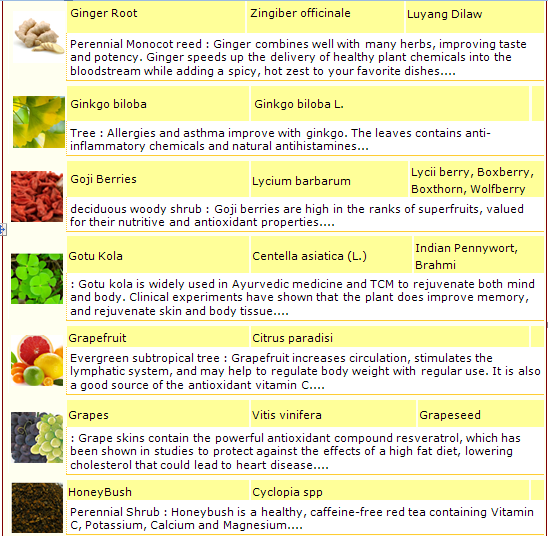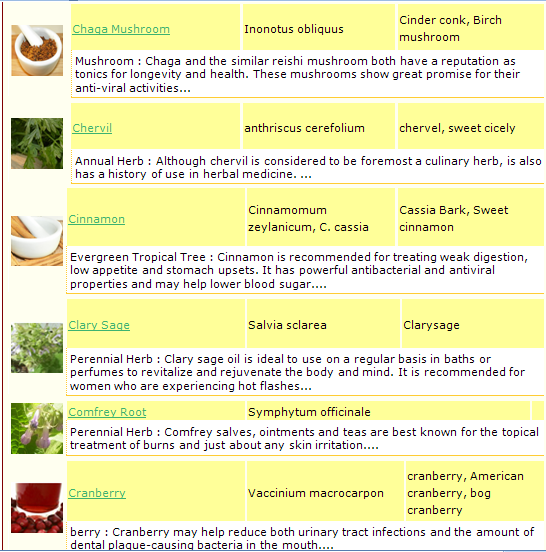Abstract:
The antioxidative activity of a total of 92 phenolic extracts from edible and nonedible plant materials (berries, fruits, vegetables, herbs, cereals, tree materials, plant sprouts, and seeds) was examined by autoxidation of methyl linoleate. The content of total phenolics in the extracts was determined spectrometrically according to the Folin-Ciocalteu procedure and calculated as gallic acid equivalents (GAE). Among edible plant materials, remarkable high antioxidant activity and high total phenolic content (GAE > 20 mg/g) were found in berries, especially aronia and crowberry. Apple extracts (two varieties) showed also strong antioxidant activity even though the total phenolic contents were low (GAE < 12.1 mg/g). Among nonedible plant materials, high activities were found in tree materials, especially in willow bark, spruce needles, pine bark and cork, and birch phloem, and in some medicinal plants including heather, bog-rosemary, willow herb, and meadowsweet. In addition, potato peel and beetroot peel extracts showed strong antioxidant effects. To utilize these significant sources of natural antioxidants, further characterization of the phenolic composition is needed.
Introduction:
The antioxidative activity of a total of 92 phenolic extracts from edible and nonedible plant materials (berries, fruits, vegetables, herbs, cereals, tree materials, plant sprouts, and seeds) was examined by autoxidation of methyl linoleate. The content of total phenolics in the extracts was determined spectrometrically according to the Folin-Ciocalteu procedure and calculated as gallic acid equivalents (GAE). Among edible plant materials, remarkable high antioxidant activity and high total phenolic content (GAE > 20 mg/g) were found in berries, especially aronia and crowberry. Apple extracts (two varieties) showed also strong antioxidant activity even though the total phenolic contents were low (GAE < 12.1 mg/g). Among nonedible plant materials, high activities were found in tree materials, especially in willow bark, spruce needles, pine bark and cork, and birch phloem, and in some medicinal plants including heather, bog-rosemary, willow herb, and meadowsweet. In addition, potato peel and beetroot peel extracts showed strong antioxidant effects. To utilize these significant sources of natural antioxidants, further characterization of the phenolic composition is needed.
Introduction:
An antioxidant is a molecule that inhibits the oxidation of other molecules. Oxidation is a chemical reaction that transfers electrons or hydrogen from a substance to an oxidizing agent. Oxidation reactions can produce free radicals.
In turn, these radicals can start chain reactions. When the chain
reaction occurs in a cell, it can cause damage or death to the cell.
Antioxidants terminate these chain reactions by removing free radical
intermediates, and inhibit other oxidation reactions. They do this by
being oxidized themselves, so antioxidants are often reducing agents
such as thiols, ascorbic acid, or
polyphenols. Although oxidation reactions are crucial for life, they
can also be damaging; plants and animals maintain complex systems of
multiple types of antioxidants, such as glutathione,
vitamin C, vitamin A, and vitamin E as well as enzymes such as
catalase, superoxide dismutase and various peroxidases. Insufficient
levels of antioxidants, or inhibition of the antioxidant enzymes, cause
oxidative stress and may damage or kill cells.
As
oxidative stress appears to be an important part of many human
diseases, the use of antioxidants in pharmacology is intensively
studied, particularly as treatments for stroke and neurodegenerative
diseases. Moreover, oxidative stress is both the cause and the
consequence of disease.
List of the medical plants having antioxidant property:
Chemical Constituents:
A
powdered preparation of freeze-dried açaí fruit pulp and skin was
reported to contain (per 100 g of dry powder) 533.9 calories, 52.2
gcarbohydrates, 8.1 g protein, and 32.5 g total fat. The carbohydrate
portion included 44.2 g of dietary fiber and low sugar value (pulp is
not sweet). The powder was also shown to contain (per 100 g): negligible
vitamin C, 260 mg calcium, 4.4 mg iron, and 1002 U vitamin A, as well
asaspartic acid and glutamic acid; the amino acid content was 7.59% of total dry weight (versus 8.1% protein).
The fat content of açaí consists of oleic acid (56.2% of total fats), palmitic acid (24.1%), and linoleic acid (12.5%). Açaí also contains beta-sitosterol (78–91% of total sterols). The oil compartments in açaí fruit contain polyphenols such as procyanidin oligomers and vanillic acid, syringic acid, p-hydroxybenzoic acid, protocatechuic acid, and ferulic acid, which were shown to degrade substantially during storage or exposure to heat.
The fat content of açaí consists of oleic acid (56.2% of total fats), palmitic acid (24.1%), and linoleic acid (12.5%). Açaí also contains beta-sitosterol (78–91% of total sterols). The oil compartments in açaí fruit contain polyphenols such as procyanidin oligomers and vanillic acid, syringic acid, p-hydroxybenzoic acid, protocatechuic acid, and ferulic acid, which were shown to degrade substantially during storage or exposure to heat.
Chemical Constituent:
Alfalfa
is high in protein, calcium, plus other minerals, vitamins in the B
group, vitamin C, vitamin D, vitamin E, and vitamin K. The sun-dried hay
of alfalfa (also known as Lucerne) has been found to be a source of vitamin D, containing 48 ng/g (1920 IU/kg) vitamin D2 and 0.63 ng/g (25 IU/kg) vitamin D3. There is reference to vitamin D2 and vitamin D3 being found in the alfalfashoot; this is awaiting verification. Mushrooms are not allowed in Jain vegetarianism, making alfalfa the only known source Jains can use to make vitamin D2 supplements.
Chemical Constituent:
Allspice
contains about 4% volatile oil, which is rather stable compared with
those of tarragon and black pepper. However, there is evidence that
storage of the undried berries under conditions that prevent rapid
removal of moisture can increase the volatile oil content by up to 50%;
it appears that enzymes released in the fruit after harvest are
responsible for producing volatile components from their precursors. The
major component of the volatile oil (known as pimenta, pimento, or
allspice oil) is eugenol, present at 60–80%. Other constituents include
methyleugenol, 1,8- cineole, l-α-phellandrene, caryophyllene, epimeric
10-cadinols (2%), β-phellandrene, camphene, and guaiene. Total
identified constituents number more than three dozen.
Other constituents of the berries
include pimentol, gallic acid, galloylglucosides, phenylpropanoids,
vanillin, quercetin glycosides, catechins, proanthocyanidins, protein,
lipids, carbohydrates, vitamins (A, C, thiamine, riboflavin, niacin),
and minerals.
The leaf oil (pimenta leaf oil) contains more eugenol (up to 96%) than the berry oil and is similar in composition to clove leaf oil. Annual leaf oil production exceeds that of the oil of the berries.
Chemical Constituent:
The apricot,
Prunus armeniaca, is a species of Prunus, classified with the plum in
the subgenus Prunus. The native range is somewhat uncertain due
Cyanogenic glycosides (found in most stone fruit seeds, bark, and leaves) are found in high concentration in apricot seeds. Laetrile, a purported alternative treatment for cancer, is extracted from apricot seeds. Apricot seeds were used against tumors as early as AD 502. In England during the 17th century, apricot oil was also used against tumors, swellings, and ulcers. In 2005, scientists in the Republic of Koreafound that treating human prostate cancer cells with amygdalin induces programmed cell death in vitro. They concluded, "amygdalin may offer a valuable option for the treatment of prostate cancers".
Cyanogenic glycosides (found in most stone fruit seeds, bark, and leaves) are found in high concentration in apricot seeds. Laetrile, a purported alternative treatment for cancer, is extracted from apricot seeds. Apricot seeds were used against tumors as early as AD 502. In England during the 17th century, apricot oil was also used against tumors, swellings, and ulcers. In 2005, scientists in the Republic of Koreafound that treating human prostate cancer cells with amygdalin induces programmed cell death in vitro. They concluded, "amygdalin may offer a valuable option for the treatment of prostate cancers".
A
2006 systematic review by the Cochrane Collaboration concluded: "The
claim that [l]aetrile has beneficial effects for cancer patients is not
supported by data from controlled clinical trials. This systematic
review has clearly identified the need for randomised or controlled
clinical trials assessing the effectiveness of aetrile or amygdalin for cancer treatment." Given the lack of evidence, laetrile has not been approved by the U.S. Food and Drug Administration.
Citral Citrussy
α–pinene Terperic, Oxidised
Citral Citrussy
α–pinene Terperic, Oxidised
Chemical Constituent:
Both triploid and tetraploid A. calamus contain alpha-asarone. Other phytochemicals include:
Beta-asarone.
eugenol.
Diploids do not contain beta-asarone (β-asarone). A recent study showed that beta-asarone isolated from Acorus calamus oil inhibits adipogenesis in3T3-L1 cells and thus reduces lipid accumulation in fat cells.
Beta-asarone.
eugenol.
Diploids do not contain beta-asarone (β-asarone). A recent study showed that beta-asarone isolated from Acorus calamus oil inhibits adipogenesis in3T3-L1 cells and thus reduces lipid accumulation in fat cells.



























No comments:
Post a Comment